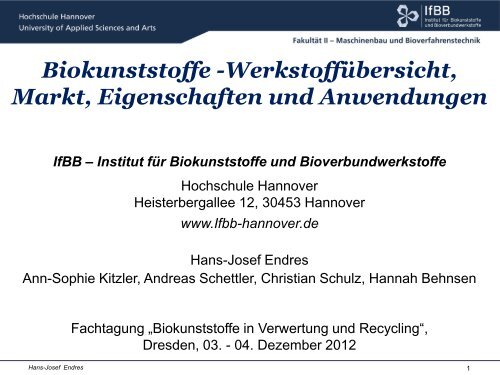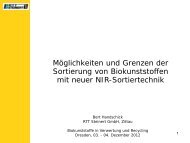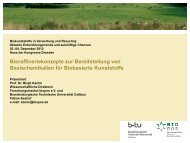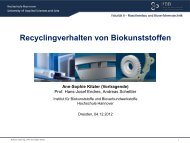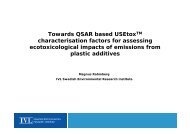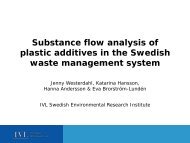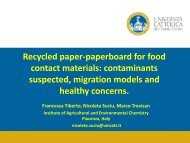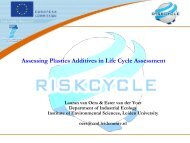Ing. Hans-Josef Endres - Tagungen in Dresden
Ing. Hans-Josef Endres - Tagungen in Dresden
Ing. Hans-Josef Endres - Tagungen in Dresden
You also want an ePaper? Increase the reach of your titles
YUMPU automatically turns print PDFs into web optimized ePapers that Google loves.
Biokunststoffe -Werkstoffübersicht,<br />
Markt, Eigenschaften und Anwendungen<br />
IfBB – Institut für Biokunststoffe und Bioverbundwerkstoffe<br />
Hochschule Hannover<br />
Heisterbergallee 12, 30453 Hannover<br />
www.Ifbb-hannover.de<br />
<strong>Hans</strong>-<strong>Josef</strong> <strong>Endres</strong><br />
Ann-Sophie Kitzler, Andreas Schettler, Christian Schulz, Hannah Behnsen<br />
Fachtagung „Biokunststoffe <strong>in</strong> Verwertung und Recycl<strong>in</strong>g“,<br />
<strong>Dresden</strong>, 03. - 04. Dezember 2012<br />
<strong>Hans</strong>-<strong>Josef</strong> <strong>Endres</strong> 1
Outl<strong>in</strong>e<br />
• Current bioplastic market trends – from niche to ma<strong>in</strong>stream<br />
• Recycl<strong>in</strong>g of bioplastics<br />
<strong>Hans</strong>-<strong>Josef</strong> <strong>Endres</strong> 2
Plastics are fantastic materials<br />
Golf 1 Golf 6<br />
costs<br />
weight<br />
Source: VW, Peter Helmke, modified<br />
<strong>Hans</strong>-<strong>Josef</strong> <strong>Endres</strong> 3
The future of plastics?<br />
Consumption of crude oil 5.000.000 x higher<br />
than its rate of regeneration<br />
future problem only to convert energy, but<br />
to meet the <strong>in</strong>creased quantity requirements<br />
for plastics will become a feedstock problem!<br />
Growth of population<br />
(Expectation: plastic consumption per head<br />
<strong>in</strong> India and Ch<strong>in</strong>a as high as <strong>in</strong> Europe)<br />
Worldwide production of plastics has to<br />
be doubled!<br />
Issue for environment:<br />
critical exploitation of oil with <strong>in</strong>creas<strong>in</strong>g<br />
ecological impacts and litter<strong>in</strong>g of plastics<br />
(globally considered)<br />
<strong>Hans</strong>-<strong>Josef</strong> <strong>Endres</strong> 4
Current Stage of Development and Production<br />
Scale of Thermoplastic Bioplastics (2012)<br />
Durables<br />
Degradables<br />
Source: H.-J. <strong>Endres</strong>, A. Siebert-Raths; Eng<strong>in</strong>eer<strong>in</strong>g Bioplymers, Carl <strong>Hans</strong>er-Verlag, 2011, modifiziert<br />
<strong>Hans</strong>-<strong>Josef</strong> <strong>Endres</strong> 5
Current Stage of Development and Production<br />
Scale of Thermoplastic Bioplastics (2012)<br />
Chemically novel biopolymer types<br />
Source: H.-J. <strong>Endres</strong>, A. Siebert-Raths; Eng<strong>in</strong>eer<strong>in</strong>g Bioplymers, Carl <strong>Hans</strong>er-Verlag, 2011, modifiziert<br />
<strong>Hans</strong>-<strong>Josef</strong> <strong>Endres</strong> 6
Global production capacity of bioplastics<br />
2011 (by type)<br />
<strong>Hans</strong>-<strong>Josef</strong> <strong>Endres</strong> 7
Global production capacity of bioplastics<br />
2016 (by type)<br />
<strong>Hans</strong>-<strong>Josef</strong> <strong>Endres</strong> 8
Global production capacity of bioplastics<br />
<strong>Hans</strong>-<strong>Josef</strong> <strong>Endres</strong> 9
Application of bioplastics 2011<br />
Degredables<br />
<strong>Hans</strong>-<strong>Josef</strong> <strong>Endres</strong> 10
Application of bioplastics 2011<br />
Drop-Ins<br />
<strong>Hans</strong>-<strong>Josef</strong> <strong>Endres</strong> 11
Application of bioplastics 2011<br />
Degredables<br />
Drop-<br />
Ins<br />
<strong>Hans</strong>-<strong>Josef</strong> <strong>Endres</strong> 12
Acreage competition<br />
<strong>Hans</strong>-<strong>Josef</strong> <strong>Endres</strong> 13
Starch content:<br />
30 wt % 70 wt % <br />
Potato<br />
Potato<br />
2100 t/km²<br />
2100 t/km²<br />
H 2 O<br />
H 2 O<br />
Potato-Starch<br />
370 t/km²<br />
Potato-Starch<br />
370 t/km²<br />
Plasticizer 1<br />
123 t<br />
Destruction<br />
(Extrusion)<br />
Plasticizer 1<br />
123 t<br />
Destruction<br />
(Extrusion)<br />
Thermoplastic<br />
Starch 493 t/km²<br />
Thermoplastic<br />
Starch 493 t/km²<br />
Polymers 2<br />
1150 t<br />
Extrusion<br />
Polymers 2<br />
211 t<br />
Extrusion<br />
Starch Blends<br />
1643 t/km²<br />
Starch Blends<br />
704 t/km²<br />
1<br />
e.g. Glycer<strong>in</strong>e, Sorbitol, Lactic Acid, Urea<br />
2<br />
e.g. PLA, Polyesters, Polyesteramides, Polyurethanes, Polyv<strong>in</strong>yl Alcohols<br />
<strong>Hans</strong>-<strong>Josef</strong> <strong>Endres</strong> 14
T<br />
Sugar Cane<br />
7000 t/km²<br />
NH3<br />
4 t<br />
H 2 O: 8 t<br />
H+/Ni<br />
1 t<br />
2 yields p.a<br />
NaOH<br />
18 t<br />
23 t<br />
Nitrile<br />
Synthesis<br />
Deca-D<strong>in</strong>itrile<br />
Deoxidation<br />
Castor Oil<br />
80 t/km²<br />
Hydrolysis<br />
Ric<strong>in</strong>oleic<br />
Acid 68 t/km²<br />
Alkal<strong>in</strong>e<br />
Crack<strong>in</strong>g<br />
Sebacic Acid<br />
46 t/km²<br />
23 t<br />
2-Octanol: 30 t<br />
Sodium: 10 t<br />
H 2 O<br />
Yeast<br />
Sugar Cane<br />
7000 t/km²<br />
Sucrose<br />
1260 t/km²<br />
Fermentation<br />
Rectification<br />
Bio-Ethanol*<br />
605 t/km²<br />
Dehydration<br />
Ethene<br />
CO 2<br />
242 t/km²<br />
H 2 O<br />
Laitance<br />
* Conversion Rate:<br />
Sucrose – Ethanol 48%<br />
H 2 O<br />
H2O<br />
Yeast<br />
O2<br />
210 t<br />
CO2<br />
492 t<br />
Sucrose<br />
1260 t/km²<br />
Fermentation<br />
Filtration<br />
CO2<br />
H2O<br />
Laitance<br />
* Conversion Rate:<br />
Ethanol* Sucrose – Ethanol 48%<br />
605 t/km²<br />
Dehydration<br />
Ethene<br />
368 t/km²<br />
Catalytic<br />
Oxidation<br />
H2O<br />
237 t<br />
Etheneoxide<br />
492 t/km²<br />
Reaction<br />
CO2: 62 t<br />
H2O: 25 t<br />
Ethene- 984 t/km²<br />
Carbonate<br />
DMDA<br />
20 t/km²<br />
Sebacic Acid<br />
23 t/km²<br />
Condensation<br />
H 2 O: 4 t<br />
Catalsyt<br />
Polymerisation<br />
Bio-PE<br />
242 t/km²<br />
H2O<br />
Reaction CO2<br />
201 t 492 t<br />
PTA<br />
1855 t<br />
MEG<br />
693 t/km²<br />
Polycondensation<br />
H2O<br />
402 t<br />
Bio-PA 10.10<br />
39 t/km²<br />
Bio-PET 30<br />
2146 t/km²<br />
<strong>Hans</strong>-<strong>Josef</strong> <strong>Endres</strong> 15
[t Biopolymer/(ha*a)]<br />
Theoretical m<strong>in</strong>imum and maximum<br />
yields per acreage of biopolymers<br />
35<br />
30<br />
25<br />
20<br />
15<br />
10<br />
5<br />
0<br />
Source: H.-J. <strong>Endres</strong>, A. Siebert-Raths,<br />
Eng<strong>in</strong>eer<strong>in</strong>g Biopolymers, <strong>Hans</strong>er Verlag 2011, modified<br />
<strong>Hans</strong>-<strong>Josef</strong> <strong>Endres</strong> 16
Land use of bioplastics (2016)<br />
Annual<br />
plastics<br />
production<br />
[10 6 t]<br />
Annual<br />
bioplastic<br />
production<br />
<strong>in</strong> 2016<br />
[10 6 t]<br />
Land use for bioplastic<br />
production <strong>in</strong> 2016<br />
(assumption 0,5 kt BP/km 2 )<br />
[km 2 ]<br />
Arable<br />
land<br />
[km 2 ]<br />
World 265 5.8 11.500 14 million<br />
EU 60 0.3 1.000 1.1 million<br />
Germany 20 0.15 500 0.12 million<br />
Lake<br />
Constance<br />
540<br />
Land use for the<br />
annual bioplastic<br />
production <strong>in</strong><br />
2016:<br />
< 0,1 % of the<br />
global arable land.<br />
Full replacement of<br />
petro-based plastics<br />
of the automotive<br />
<strong>in</strong>dustry with<br />
bioplastics requires<br />
< 0,3 % of the global<br />
arable land.<br />
Full replacement of<br />
petro-based plastics<br />
of the packag<strong>in</strong>g<br />
<strong>in</strong>dustry with<br />
bioplastics requires<br />
< 2% of the global<br />
arable land.<br />
Full replacement of<br />
total petro-based<br />
plastics with<br />
bioplastics<br />
requires<br />
< 5 % of the global<br />
arable land.<br />
<strong>Hans</strong>-<strong>Josef</strong> <strong>Endres</strong> 17
Global production capacity of bioplastics<br />
2011 (by type)<br />
Europe‘s share of the global bioplastics production capacity is shr<strong>in</strong>k<strong>in</strong>g!<br />
<strong>Hans</strong>-<strong>Josef</strong> <strong>Endres</strong> 18
A closer and comprehensive look at the<br />
bioplastic market will be published by the IfBB<br />
partly <strong>in</strong> cooperation with EuBP end of 2012<br />
Contents:<br />
• Production capacities (worldwide and by regions)<br />
• List of all producers of bioplastics worldwide<br />
• Material types<br />
• Market segments and applications<br />
• Ma<strong>in</strong> applications for selected bioplastics<br />
• Share of bioplastics relat<strong>in</strong>g to the total plastic markets<br />
• Feedstock<br />
• Land use<br />
• Future trends<br />
• Etc.<br />
<strong>Hans</strong>-<strong>Josef</strong> <strong>Endres</strong> 19
Outl<strong>in</strong>e<br />
• Current bioplastic market trends – from niche to ma<strong>in</strong>stream<br />
• Recycl<strong>in</strong>g of bioplastics<br />
<strong>Hans</strong>-<strong>Josef</strong> <strong>Endres</strong> 20
End-of-Life / New-Life Options of Bioplastics<br />
Metabolism<br />
<strong>in</strong> organism<br />
Neutral<br />
Inc<strong>in</strong>eration<br />
Landfill<br />
Anaerobic<br />
digestion<br />
(Bio-methane)<br />
Litter<br />
Biopolymer<br />
product<br />
Decomposition<br />
<strong>in</strong> soil<br />
Dissolv<strong>in</strong>g <strong>in</strong><br />
(salt) water<br />
Chemical<br />
Recycl<strong>in</strong>g<br />
Mechanical<br />
Recyl<strong>in</strong>g<br />
Industrial<br />
Compost<strong>in</strong>g<br />
Domestic<br />
compost<strong>in</strong>g<br />
Source: H.-J. <strong>Endres</strong>, A. Siebert, A.-S. Kitzler<br />
Biopolymers – a discussion on end of life options<br />
Bioplastics Magaz<strong>in</strong>e 01/08<br />
<strong>Hans</strong>-<strong>Josef</strong> <strong>Endres</strong> 21
Pre- and Post-consumer Recycl<strong>in</strong>g<br />
Recycl<strong>in</strong>g<br />
Pre-consumer<br />
Post-consumer<br />
Production<br />
waste<br />
Waste of<br />
events<br />
Household<br />
garbage<br />
unalloyed<br />
alloys<br />
lam<strong>in</strong>ates<br />
almost<br />
unalloyed,<br />
contam<strong>in</strong>ated<br />
with food<br />
Material mixture,<br />
composites, alloys<br />
polluted<br />
<strong>Hans</strong>-<strong>Josef</strong> <strong>Endres</strong> 22
Influence of repeated thermo-mechanical<br />
stress on result<strong>in</strong>g mechanical properties<br />
<strong>Hans</strong>-<strong>Josef</strong> <strong>Endres</strong> 23
Viskosität [Pa*s]<br />
Influence of repeated thermo-mechanical<br />
stress on process<strong>in</strong>g behaviour<br />
1.000,00<br />
313,33<br />
250,48<br />
196,13<br />
157,39<br />
100,00<br />
170,48<br />
138,94<br />
81,77<br />
78,62<br />
43,87<br />
43,30<br />
34,84<br />
34,95<br />
22,87<br />
22,96<br />
18,65<br />
10,00<br />
100,00 1.000,00 10.000,00 100.000,00<br />
Schergeschw<strong>in</strong>digkeit [1/s]<br />
PLA unextrudiert PLA 3-fachextrudiert<br />
<strong>Hans</strong>-<strong>Josef</strong> <strong>Endres</strong> 24
Pre-consumer Recycl<strong>in</strong>g of Bioplastics<br />
• First successful experiences with the pre-consumer<br />
recycl<strong>in</strong>g of thermoplastic bioplastics<br />
• Some biopolymers show less thermo-mechanical and<br />
chemical stability, i.e. stronger down cycl<strong>in</strong>g effects<br />
stabilization necessary<br />
• Desire for mono-fractional waste streams like conventional<br />
recyclates (PET,…)<br />
<strong>Hans</strong>-<strong>Josef</strong> <strong>Endres</strong> 25
Identification of Biopolymers<br />
by Near Infrared Spectroscopy (NIR)<br />
<strong>Hans</strong>-<strong>Josef</strong> <strong>Endres</strong> 26
Post-consumer Recycl<strong>in</strong>g<br />
Post-consumer recycl<strong>in</strong>g<br />
Conventional<br />
Plastics<br />
PET<br />
PS<br />
PE HD<br />
PE-LD<br />
Bioplastics<br />
Blend amount:<br />
0,5; 1; 3; 5 und 10 wt-%<br />
PTT<br />
PLA<br />
PBAT Blends<br />
Starch Blends<br />
PLA Blends<br />
<strong>Hans</strong>-<strong>Josef</strong> <strong>Endres</strong> 27
Influence of Ecovio on mechanical<br />
properties of LDPE<br />
<strong>Hans</strong>-<strong>Josef</strong> <strong>Endres</strong> 28
Influence of Ecovio on process<strong>in</strong>g<br />
properties of LDPE<br />
<strong>Hans</strong>-<strong>Josef</strong> <strong>Endres</strong> 29
Post-consumer Recycl<strong>in</strong>g of mixed Waste<br />
• Differentiation between “drop-<strong>in</strong>s” and chemical new biopolymers<br />
• Consideration of exist<strong>in</strong>g waste logistic<br />
‣ What about PLA <strong>in</strong> (Bio-)PET- or PS-recycl<strong>in</strong>g stream?<br />
‣ Interaction of Ecovio and/or MaterBi with (Bio-)PE<br />
‣ What about (Bio-)PET, PS etc. <strong>in</strong> PLA or (Bio-)PE, MaterBi etc. <strong>in</strong><br />
Ecovio?<br />
‣ Mix<strong>in</strong>g of different grades of one biopolymere (e.g. PLAs)<br />
‣ Quality of recycled bioplastics<br />
‣ Possibilities to improve the recycl<strong>in</strong>g behavior of Bioplastics<br />
‣ Influence of bioplastic additives or contam<strong>in</strong>ation with residuals<br />
These and further recycl<strong>in</strong>g questions will be answered <strong>in</strong><br />
runn<strong>in</strong>g <strong>in</strong>vestigations together with different research and<br />
<strong>in</strong>dustrial partners like BASF, DuPont or Rhe<strong>in</strong>Chemie<br />
<strong>Hans</strong>-<strong>Josef</strong> <strong>Endres</strong> 30
Conclusion<br />
• Bioplastics are also “only” plastics<br />
• Recycl<strong>in</strong>g of bioplastics is subject to the same requirements as it is for recycl<strong>in</strong>g<br />
of conventional plastics (sort<strong>in</strong>g accuracy, stabilization, additives…)<br />
• Successful preconsumer recycl<strong>in</strong>g of bioplastics<br />
• “Drop-Ins” are no problem for recycl<strong>in</strong>g<br />
• Separation and recycl<strong>in</strong>g of chemical new “non drop-<strong>in</strong> bioplastics” (PLA, Starch<br />
Blends, PHAs, PBS,…) is because of their small amounts still not economic.<br />
• Chemical new bioplastics are therefore as a m<strong>in</strong>ority <strong>in</strong> the waste disposal<br />
process a potential risk for contam<strong>in</strong>ation for established recyceled plastics.<br />
• Also mixed bioplastics of different types (e.g. Ecovio + MaterBi + LDPE) as well<br />
as of same types (for example different PLA grades) should be considered.<br />
• Further, “vice versa” contam<strong>in</strong>ation scenarios have to be exam<strong>in</strong>ed (for example<br />
PET, PS <strong>in</strong> PLA or LDPE <strong>in</strong> MaterBi or Ecovio).<br />
Instead of emotional discussions, more facts are needed related to the<br />
recycl<strong>in</strong>g of bioplastics<br />
<strong>Hans</strong>-<strong>Josef</strong> <strong>Endres</strong> 31
Thanks for the attention<br />
http://www.hanser.de/buch.asp?isbn=978-3-446-42403-6&area=Technik<br />
For more<br />
<strong>in</strong>formation<br />
please see:<br />
http://www.hanser.de/buch.asp?isbn=3-446-41683-8&area=Technik<br />
and www.materialdatacenter.com<br />
<strong>Hans</strong>-<strong>Josef</strong> <strong>Endres</strong> 32
Contact<br />
Prof. Dr.-<strong>Ing</strong>. <strong>Hans</strong>-<strong>Josef</strong> <strong>Endres</strong><br />
IfBB - Institut für Biokunststoffe und Bioverbundwerkstoffe<br />
Hochschule Hannover<br />
Fakultät Masch<strong>in</strong>enbau und Bioverfahrenstechnik<br />
Heisterbergallee 12<br />
D-30453 Hannover<br />
Tel.: 0049 (0)511-9296-2212<br />
Fax: 0049 (0)511-9296-2210<br />
Email: hans-josef.endres@hs-hannover.de<br />
Internet: www.ifbb-hannover.de<br />
<strong>Hans</strong>-<strong>Josef</strong> <strong>Endres</strong> 33


